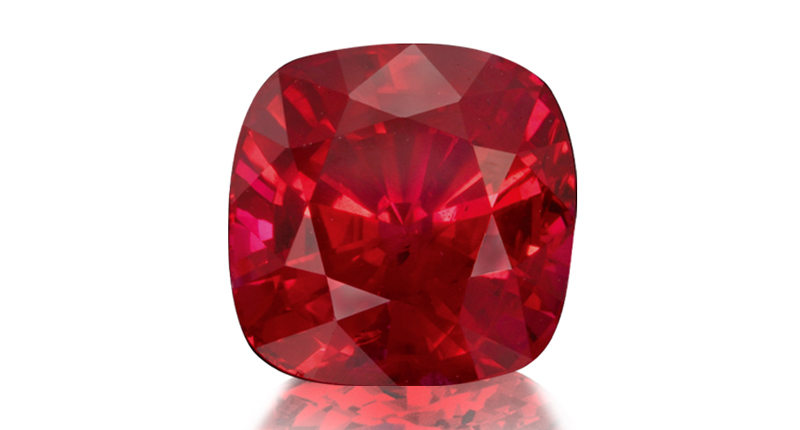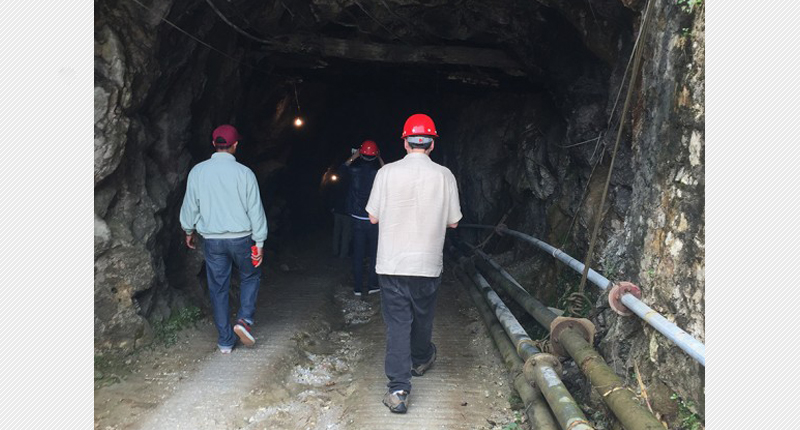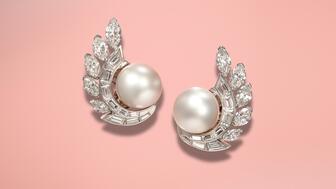The historic fancy vivid blue diamond set to headline Christie’s Geneva sale next month could sell for up to $50 million.
5 Things to Know About … Burmese Rubies
Senior Editor Brecken Branstrator details a few interesting facts about the stones, which have been allowed back into the U.S. for the first time in nearly a decade.

For my first “5 Things to Know About…” blog post, I chose these stones because they are topical, with the lift of the remaining sanctions and the likelihood that they will be at the upcoming gems shows in Tucson for the first time in a while.
I, for one, hope I can get my hands on at least a few while I’m out in the desert.
In the meantime, here’s are five facts about the gemstones pulled together with the help of a number of experts.
1. The color of fine Burmese rubies comes a result of two factors. According to “Ruby & Sapphire: A Gemologist’s Guide” by Richard Hughes, the first factor is a combination of the slightly bluish-red body color of the gemstone and the “purer” red fluorescent emission, which work together to give the gemstone its high-intensity color.
The second is the presence of “silk”--tiny inclusions scatter light onto “facets that would otherwise be extinct,” giving the color a softness and greater dispersion across the gem’s face.
And while rubies from other sources also can possess the strong red fluorescence and “silk” comparable to those sourced in Myanmar (formerly known as Burma), it’s the particular combination of “fine color … and facetable material (i.e., internally clean)” that puts Burmese rubies at the top.
2. Burmese rubies are much younger than those from East Africa. This is actually true for all rubies created by the collision of the Indian subcontinent with the Asian continent.
During certain times in history, tectonic movement has resulted in large-scale shifts in the Earth’s surface, resulting in mineral formation and creating regions called orogenic belts. A lot of the finest ruby and sapphire mines fall into such zones, according to Hughes’ book.
The Pan-African orogeny happened about 750 to 450 million years ago, the result of which created gem deposits in Kenya, Tanzania, Mozambique, Madagascar, Sri Lanka and southern India.

Meanwhile, the activity that resulted in the Himalayan region--the Indian subcontinent colliding with the Asian continent--occurred “just” 45 to 5 million years ago. This created ruby and sapphire deposits from Afghanistan and Tajikistan through Pakistan, northern India, Nepal and Myanmar, and onward to China and Vietnam.
Though there currently is no easy way to age-date rubies, Hughes said if we could, it would provide a method for separating Himalayan rubies from those sourced in East Africa and Sri Lanka.
3. There isn’t a great deal of fine quality rubies coming out of Burma right now. Most of the alluvial deposits in the Mogok region are mined out, according to Hughes.
He said the best gemstones come from alluvial deposits because millions of years of weathering naturally removes the impure cracked portions, which leaves behind the purest part of the crystal.
But now, without the alluvial sources, mining increasingly involves hard rock, which has lower yields and keeps production low.
In a blog post published shortly after the ban was officially lifted in October, Omi Gems also noted that even while the ban was in place in the U.S., Burmese rubies still were being exported to other countries but “supply was still not meeting that (high) demand.” This means that there’s no great supply ready to be sent to the U.S., Omi added, and that prices are likely to remain high.
4. Burmese rubies can be compared to fine rubies from Mozambique. While there are a lot of great rubies coming from other sources, it was the discovery of the fine stones from Mozambique in the late 2000s that made a great splash in the gem world, especially given the ban on Burmese material.
Where a strong presence of iron gives many other sources a slightly brownish hue, the material from Mozambique varies in iron content, so its rubies can have a fluorescence and color hues in similar to the classic colors of Burmese rubies, according to gemologist Richard Wise’s “Secrets of the Gem Trade (Second Edition).”
In his book, Wise wrote that he has seen several stones from Mozambique that “rival, in hue, saturation the best Burma has to offer.”
This is good news for the industry given that there’s so little coming out of Myanmar right now, as mentioned before, and as Mozambique rubies today make up a large part of what’s on the market.
Wise, in fact, estimates that about 85 percent of the ruby market today is made up of Mozambican goods.
And as production from Myanmar continues to decrease--assuming the supply of Mozambican rubies remains strong--he price gap between Burmese and African rubies likely will continue to get smaller.

5. The conflict surrounding Burmese rubies has changed. The U.S. declared a “national emergency” with respect to the Burmese military’s rise to power in 1997 and started to impose sanctions on the country a short time later.
The U.S. government then specifically targeted the import of gemstones with the Tom Lantos Block Burmese JADE (Junta’s Anti-Democratic Efforts) Act of 2008, noting the human rights violations of the ruling regime and how it was evading sanctions by concealing gemstone origins to continue their export to the U.S.
Now, as we all know, the remainder of those sanctions have been lifted and rubies can once again be shipped into the country.
In October, leaders from the American Gem Trade Association and Jewelers of America took a trip to Myanmar to discuss trade between countries. While they were there, the group traveled to Mogok, the center of the gemstone trade in Myanmar and traditionally the source for the best rubies, to visit mines and with miners and dealers.
The AGTA has since released a report on its findings and the recommendations the delegation is making to officials of Myanmar.
The report states that “most of Myanmar’s rubies are in conflict-free zones, with the exception of small deposits in Mongshu in Shan State.”
Thus, the safety of workers, mine operators and prospectors, is greater and the “likelihood of indirectly funding armed conflict is less,” the report states.
(This is, of course, looking specifically at rubies in Myanmar. Jade and the problems surrounding it are a separate issue.)
Still, the AGTA hade made recommendations to the country’s officials on how to make their gemstone industry more transparent and develop it--including separating jade from other gemstones when it comes to licenses and regulations--and will continue to help it develop in the future.
The Latest

LVMH CFO Cécile Cabanis also discussed the effects of tariffs so far.

The “Mad Men” and “The Morning Show” star steals jewelry, art, and handbags from his wealthy neighbors in “Your Friends & Neighbors.”

The organization has reelected Kalpesh Jhaveri as president.


An investigation found that the former managing director of Movado’s Dubai branch overstated and prematurely recorded sales.

The collection pays tribute to the Japanese philosophy of Ma, studying balance, stillness, and the interplay between presence and absence.

Bench jewelers spend years honing their skills, Jewelers of America’s Certification validates their talents.

Mari Lou’s Fine Jewelry in Orland Park, a suburb of Chicago, is closing its doors.

GIA’s labs in Dubai and Hong Kong are now accepting larger diamonds in light of the “logistical challenges” presented by the new tariffs.

These earrings by Van Cleef & Arpels, featuring the same design as a pair worn by Princess Grace, are up for auction at Woolley & Wallis.

Two experts share how artificial intelligence tools can help retailers run a more efficient business.

Kentaro Nishimura, who has been with the pearl company since 1997, has been promoted to president and CEO of Mikimoto America.

“America Telling Time: 150 Years of Bulova” explores the storied history of the American watchmaker.

An across-the-board tariff of 10 percent remains in place for all U.S. trading partners, except China.

Brigette Pheloung and Tania Sarin, and their mothers, star in the campaign wearing medallions they co-designed.

LeVian is remembered for her unwavering commitment to her family, community, and helping others.

The retail show is open to the public and will run July 24-27.

The new store in the upscale Iguatemi São Paulo mall is the storied brand’s first flagship in Brazil.

The pieces span from the Art Deco period to the 1970s and will go up for auction at the Paris Jewels sale later this month.

The Grammy-winning singer-songwriter, who is set to perform at Coachella this month, also debuted a curated selection from the brand.

The introductions include the Land-Dweller, Rolex’s first new model since 2012, as well as several new dials for its classic timepieces.

Cowlishaw earned a degree in horology after serving in World War II, working at one of the first Zales stores in Tulsa, Oklahoma.

Bonhams will offer the “Kat Florence Lumina” at its May 22 jewelry auction.

In March 2022, the men went into a jewelry store in Beverly Hills and smashed the display cases with sledgehammers and crowbars.

The 51 unique watches from Sotheby’s three-day sale and immersive exhibition all found buyers, with the top lot selling for $229,955.




























